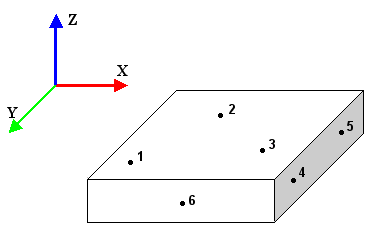To unambiguously fix the position of a part in 3D space, you must lock its three axes of translation and three axes of rotation. The simplest method of doing this is to measure six points on three of the part's surfaces: three points to define a plane; two points to define an axis; and one point to define a position. This is called the 3-2-1 rule.
In the following example:
- Points 1, 2, and 3 specify a plane. This locks two rotation and one translation axis.
- Points 4 and 5 specify a line. This locks one rotation and one translation axis.
The order of the points specifies the direction of the line.
- Point 6 specifies a second line, orthogonal to the plane axis and the line created by points 4 and 5. This locks the remaining translation axis.
